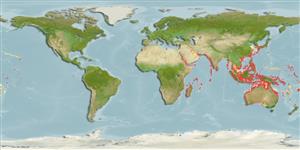Common names from other countries
Environment: milieu / climate zone / depth range / distribution range
Écologie
; profondeur 0 - 50 m (Ref. 348). Tropical; 35°N - 37°S, 29°E - 154°W
Indo-West Pacific: from East and southeast Africa, including Madagascar, Mauritius Island, the Red Sea and the Persian Gulf, to New Caledonia; north to Japan and south to South Australia. Generally absent from oceanic islands of the central Indian Ocean and the tropical West Pacific, but sporadically found in Hawaii.
Length at first maturity / Taille / Poids / Âge
Maturity: Lm ? range ? - ? cm Max length : 50.0 cm SHL mâle / non sexé; (Ref. 348); common length : 40.0 cm SHL mâle / non sexé; (Ref. 348); âge max. reporté: 18 années (Ref. 107096)
Species of minor economic importance, and collected for subsistence fisheries (Ref. 348). Maximum depth from Ref. 101118.
Life cycle and mating behavior
Maturité | Reproduction | Frai | Œufs | Fécondité | Larves
Planktonic larval stage (Ref. 348).
Poutiers, J.M. 1998. (Ref. 348)
Statut dans la liste rouge de l'IUCN (Ref. 130435: Version 2024-1)
statut CITES (Ref. 108899)
Not Evaluated
Not Evaluated
Utilisations par l'homme
Pêcheries: commercial
| FishSource | Sea Around Us
Outils
Sources Internet
Estimates based on models
Preferred temperature
(Ref.
115969): 18.7 - 29.1, mean 27.9 (based on 1460 cells).
Résilience
Haut, temps minimum de doublement de population inférieur à 15 mois (K=0.88).
Prior r = 0.84, 95% CL = 0.56 - 1.27, Based on 1 data-limited stock assessment.
Vulnérabilité
Moderate vulnerability (38 of 100).
Catégorie de prix
Unknown.
